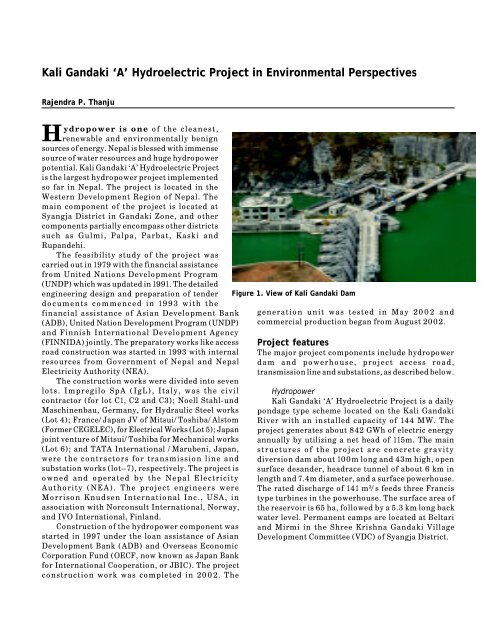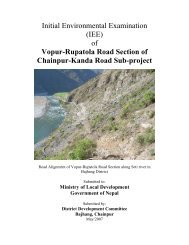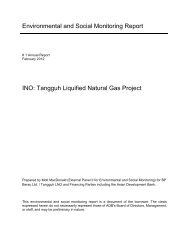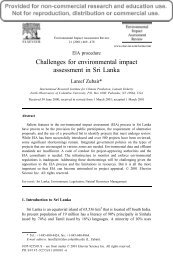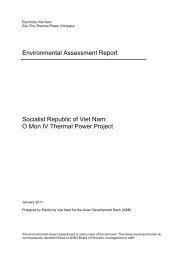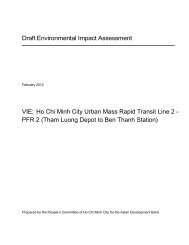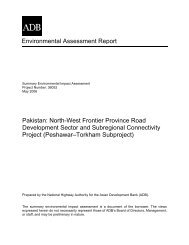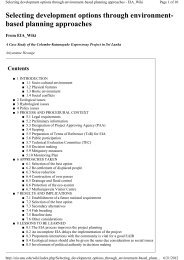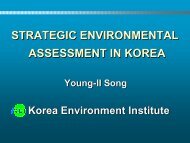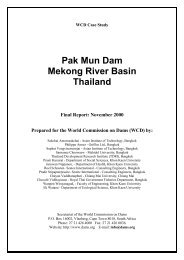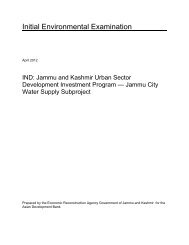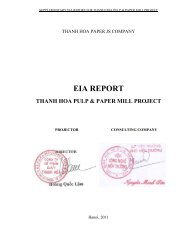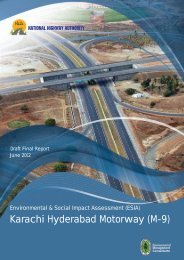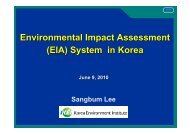Kali Gandaki 'A' Hydroelectric Project in Environmental ... - AECEN
Kali Gandaki 'A' Hydroelectric Project in Environmental ... - AECEN
Kali Gandaki 'A' Hydroelectric Project in Environmental ... - AECEN
Create successful ePaper yourself
Turn your PDF publications into a flip-book with our unique Google optimized e-Paper software.
<strong>Kali</strong> <strong>Gandaki</strong> ‘A’ <strong>Hydroelectric</strong> <strong>Project</strong> <strong>in</strong> <strong>Environmental</strong> PerspectivesRajendra P. ThanjuHydropower is one of the cleanest,renewable and environmentally benignsources of energy. Nepal is blessed with immensesource of water resources and huge hydropowerpotential. <strong>Kali</strong> <strong>Gandaki</strong> ‘A’ <strong>Hydroelectric</strong> <strong>Project</strong>is the largest hydropower project implementedso far <strong>in</strong> Nepal. The project is located <strong>in</strong> theWestern Development Region of Nepal. Thema<strong>in</strong> component of the project is located atSyangja District <strong>in</strong> <strong>Gandaki</strong> Zone, and othercomponents partially encompass other districtssuch as Gulmi, Palpa, Parbat, Kaski andRupandehi.The feasibility study of the project wascarried out <strong>in</strong> 1979 with the f<strong>in</strong>ancial assistancefrom United Nations Development Program(UNDP) which was updated <strong>in</strong> 1991. The detailedeng<strong>in</strong>eer<strong>in</strong>g design and preparation of tenderdocuments commenced <strong>in</strong> 1993 with thef<strong>in</strong>ancial assistance of Asian Development Bank(ADB), United Nation Development Program (UNDP)and F<strong>in</strong>nish International Development Agency(FINNIDA) jo<strong>in</strong>tly. The preparatory works like accessroad construction was started <strong>in</strong> 1993 with <strong>in</strong>ternalresources from Government of Nepal and NepalElectricity Authority (NEA).The construction works were divided <strong>in</strong>to sevenlots. Impregilo SpA (IgL), Italy, was the civilcontractor (for lot C1, C2 and C3); Noell Stahl-undMasch<strong>in</strong>enbau, Germany, for Hydraulic Steel works(Lot 4); France/Japan JV of Mitsui/Toshiba/Alstom(Former CEGELEC), for Electrical Works (Lot 5); Japanjo<strong>in</strong>t venture of Mitsui/Toshiba for Mechanical works(Lot 6); and TATA International /Marubeni, Japan,were the contractors for transmission l<strong>in</strong>e andsubstation works (lot–7), respectively. The project isowned and operated by the Nepal ElectricityAuthority (NEA). The project eng<strong>in</strong>eers wereMorrison Knudsen International Inc., USA, <strong>in</strong>association with Norconsult International, Norway,and IVO International, F<strong>in</strong>land.Construction of the hydropower component wasstarted <strong>in</strong> 1997 under the loan assistance of AsianDevelopment Bank (ADB) and Overseas EconomicCorporation Fund (OECF, now known as Japan Bankfor International Cooperation, or JBIC). The projectconstruction work was completed <strong>in</strong> 2002. TheFigure 1. View of <strong>Kali</strong> <strong>Gandaki</strong> Damgeneration unit was tested <strong>in</strong> May 2002 andcommercial production began from August 2002.<strong>Project</strong> featuresThe major project components <strong>in</strong>clude hydropowerdam and powerhouse, project access road,transmission l<strong>in</strong>e and substations, as described below.Hydropower<strong>Kali</strong> <strong>Gandaki</strong> ‘A’ <strong>Hydroelectric</strong> <strong>Project</strong> is a dailypondage type scheme located on the <strong>Kali</strong> <strong>Gandaki</strong>River with an <strong>in</strong>stalled capacity of 144 MW. Theproject generates about 842 GWh of electric energyannually by utiliz<strong>in</strong>g a net head of 115m. The ma<strong>in</strong>structures of the project are concrete gravitydiversion dam about 100m long and 43m high, opensurface desander, headrace tunnel of about 6 km <strong>in</strong>length and 7.4m diameter, and a surface powerhouse.The rated discharge of 141 m 3 /s feeds three Francistype turb<strong>in</strong>es <strong>in</strong> the powerhouse. The surface area ofthe reservoir is 65 ha, followed by a 5.3 km long backwater level. Permanent camps are located at Beltariand Mirmi <strong>in</strong> the Shree Krishna <strong>Gandaki</strong> VillageDevelopment Committee (VDC) of Syangja District.
Access roadThe access road of the project crosses steep andhilly terra<strong>in</strong>. Total length of the access roads is about28.5 km. The access road starts from Batuwa, 82 kmfrom Pokhara on Siddhartha highway (3.5 south ofGalyang Bazaar) and ends at the left bank of the dam,which is about 20 km away from the highway. Theaccess road for the powerhouse branch out fromJaipate is about 8 km long.Transmission l<strong>in</strong>esThe power generated from the project by 3 unitsof turb<strong>in</strong>es of 48 MW each capacity is evacuated tothe central grid via a 132 kV s<strong>in</strong>gle circuit, a 66 kmlong transmission l<strong>in</strong>e to Pokhara and a 44 km doublecircuit transmission l<strong>in</strong>e to Butwal. A sub-station isconstructed at Lekhnath Municipality of KaskiDistrict, whereas the pre-exist<strong>in</strong>g Jogikuti substationof Butwal has been upgraded.<strong>Environmental</strong> studiesFrom the <strong>in</strong>itial stage of project, environmentalconcerns were the <strong>in</strong>tegral part of design optimization.The environmental studies/activities of the projectdur<strong>in</strong>g pre-project, construction stage and operationphase are briefly described below.Pre-project phaseThe <strong>Environmental</strong> Impact Assessment (EIA)study was conducted <strong>in</strong> 1996 accord<strong>in</strong>g to NationalEIA Guidel<strong>in</strong>es of 1993 and Asian Development BankGuidel<strong>in</strong>es of 1990. The report was duly approved bythe Asian Development Bank (ADB).The <strong>in</strong>teraction and consultation programs dur<strong>in</strong>gthe project preparation stage reflected views ofdifferent stakeholders, which were considered <strong>in</strong> thedetailed design phase of the project, and possibleFigure 2. Boat transportation <strong>in</strong> project reservoiradverse environmental impacts were avoided to theextent possible.<strong>Environmental</strong> documentsFrom the beg<strong>in</strong>n<strong>in</strong>g, environmental considerationwas given priority <strong>in</strong> the project. Variousenvironmental documents were prepared dur<strong>in</strong>geng<strong>in</strong>eer<strong>in</strong>g design and tender documentspreparation. The primary documents that guidedenvironmental activities of the project are givenbelow. These documents were used <strong>in</strong> cross-referencewith each other:• <strong>Environmental</strong> Impact Assessment(EIA), Vol. 1-2, 1996.• Mitigation Management and Monitor<strong>in</strong>gPlan (MMMP), 1996.• Acquisition, Compensation and RehabilitationPlan (ACRP), 1996.• Tender documents with conditions ofparticular applications, <strong>in</strong>clud<strong>in</strong>g socialand environmental clauses.• ADB: Summary Environment ImpactAssessment (SEIA), 1996• ADB: Report and Recommendation ofPresident to Board of Directors, 1996RRP-NEP 26362)• Loan Agreement with ADBThe EIA expla<strong>in</strong>ed the impacts and proposedmitigation measures as identified dur<strong>in</strong>g the detailstudy of the project and provides justification for themitigation. The MMMP described how the mitigationspelled out <strong>in</strong> the EIA, ACRP and <strong>in</strong> Tender Clauseswill be carried out. The MMMP provided a guide tomitigation management and environmentalmonitor<strong>in</strong>g. The ma<strong>in</strong> objective of ACRPwas to <strong>in</strong>sure that people affected byproject-related property and landacquisitions would be as well off after theproject as they were before. The TenderDocuments specified what actionconstruction contractors were required totake to protect the environment.In addition, the contractors wererequired to develop an <strong>Environmental</strong>Protection Plan, a Health and Safety Planand a Waste Management Plan, andcontractors disturb<strong>in</strong>g vegetation wererequired to submit a Revegetation Plan.These Plans augmented the MMMP andspecified how the contractors met andimplemented the environmentalmitigation requirements specified <strong>in</strong> the
EIA, ACRP and the Tender Documents.The loan document between ADB and NEA def<strong>in</strong>edthe role, responsibility and mandate of <strong>Kali</strong> <strong>Gandaki</strong><strong>Environmental</strong> Management Unit (KGEMU). The loandocument <strong>in</strong>cluded basic provisions <strong>in</strong> environmentalaspects, which were to be carefully addressed tocomply with ADB’s policies and procedures. Included<strong>in</strong> this document are: <strong>in</strong>stitutional requirement formonitor<strong>in</strong>g; establishment of the KGEMU; provisionfor a construction stage International Panel of Experts(POE) 1 on environmental and social aspects;implementation of MMMP; contractors’ compliancewith tender clauses; compensatory flow of 4 m 3 /s;operation and management of a fish hatcheryprogram; and clauses regard<strong>in</strong>g m<strong>in</strong>imization ofresettlement, enabl<strong>in</strong>g communities to benefit fromthe project, preferential hir<strong>in</strong>g, and the need for publicconsultation.Social mitigation policyThe Resettlement Policy def<strong>in</strong>ed <strong>in</strong> projectdocuments provides that the Government of Nepaland the NEA shall take or cause to be taken allnecessary measures to ensure that all the populationadversely affected by carry<strong>in</strong>g out the project shallgenerally:• improve or at least rega<strong>in</strong> their prior standardof liv<strong>in</strong>g;• be relocated, if necessary, <strong>in</strong> accordance withtheir preferences and be fully <strong>in</strong>tegrated <strong>in</strong>tothe community <strong>in</strong> which they move; and• be provided with appropriate, agreed uponcompensation and required physicalrehabilitation of <strong>in</strong>frastructures, communityfacilities, <strong>in</strong>clud<strong>in</strong>g rehabilitation grants, skilltra<strong>in</strong><strong>in</strong>g and employment opportunities. Allsuch measures should at least satisfy therequirement of the ACRP.<strong>Environmental</strong> impactsMajor impacts occurred due to the implementationof the project on physical, biological andsocioeconomic and cultural environment aresummarized below:Physical environment• Submergence of forest land and other landuses due to creation of 5.3 km long (65 ha)reservoir.• Hydrological changes <strong>in</strong> the 13 km stretchdownstream between the dam and theconfluence with the major tributary, Badi Gad.• Impacts on hydrology downstream of thepower plant are restricted to the dry seasonwhen the facility is used for peak<strong>in</strong>g. Thechanges <strong>in</strong> flow and stage pose hazards towater users immediately below the powerplant site.• Generation of 6.2 million tons of muck/spoil.Biological environment• Removal of 6,093 trees of various species(khayar, baka<strong>in</strong>o, ipil-ipil, simal, sissoo andsal) due to implementation of the project.• Soil erosion and land slides due to projectconstruction works.• Loss of wildlife habitat around dam,powerhouse sites and nearby areas.• Impact on migration of long range migratoryfishes due to damm<strong>in</strong>g of river.Social/cultural environment• Loss of approximately 208.68 ha of land dueto placement of project structures andfacilities, <strong>in</strong>clud<strong>in</strong>g access road.• Altogether 1,468 families lost their land (orpart of it), their houses, or both, out of which263 families were def<strong>in</strong>ed as SPAF 2 and 1,205families as PAF 3 .• Impacts to <strong>in</strong>digenous Bote (fisherman)community. About 21 houses, 5 cowshed andapproximately 13 ropani of land from theBote families were acquired.• Impact on Setibeni Sheela, a religious site.• Reduction of white water raft<strong>in</strong>g <strong>in</strong> <strong>Kali</strong><strong>Gandaki</strong> River from 5 days to 3 days.<strong>Environmental</strong> monitor<strong>in</strong>g and mitigationmanagementThe Nepal Electricity Authority, project eng<strong>in</strong>eersand contractors were responsible for the monitor<strong>in</strong>gand implementation and management of mitigationmeasures. KGEMU was the key unit established underthe consultant umbrella to monitor environmentalmitigation measures carried out by contractors, tocarry out environmental mitigation programs andconduct environmental monitor<strong>in</strong>g dur<strong>in</strong>g theconstruction phase, as spelled out <strong>in</strong> EIA, MMMP andTender Documents.The environmental monitor<strong>in</strong>g and mitigationmanagement activities carried out dur<strong>in</strong>g the projectconstruction stage are briefly described below.<strong>Kali</strong> <strong>Gandaki</strong> <strong>Environmental</strong> Management Unit(KGEMU)The KGEMU was formed <strong>in</strong> January 1997 with thecommencement of project construction. It was thefirst organization of its k<strong>in</strong>d <strong>in</strong> hydropower projects
<strong>in</strong> Nepal to monitor and mitigate the adverseenvironmental impacts due to the projectconstruction and was established as per the provision<strong>in</strong> the loan agreement between NEA and ADB.Consider<strong>in</strong>g multidimensional activities and mandate,KGEMU was staffed with a diverse group ofenvironmental professionals. The environmentaladvisor and tra<strong>in</strong>er, an expatriate position, wasresponsible for review<strong>in</strong>g the performance andmanage KGEMU for the first year. Moreover, anexpatriate manager and an International Panel ofExperts (environmental and social) were also engagedto guide and review the environmental and socialworks of the project throughout the projectconstruction stage.Monitor<strong>in</strong>g activities were considered animportant aspect. KGEMU staff conductedcompliance monitor<strong>in</strong>g of the <strong>in</strong>ternationalcontractors regard<strong>in</strong>g environmental obligations asmentioned <strong>in</strong> the contract documents. About 108environmental and social clauses were <strong>in</strong>corporated<strong>in</strong> tender documents of the civil contractor (IgL).Significant shortcom<strong>in</strong>gs on the part ofcontractors were documented and <strong>in</strong>formed to therelevant contractors for necessary improvements.Several eng<strong>in</strong>eer’s <strong>in</strong>structions were issued to thecontractors to make them comply with theircontractual obligations. However, the contractors’environmental compliance status was satisfactory,but needs greater enforcement mechanism to achievebetter performance <strong>in</strong> future projects.Social research and impacts studiesThe professional staff of the KGEMU conductedseveral impacts monitor<strong>in</strong>g studies among the affectedpopulace of the project areas dur<strong>in</strong>g the period of theproject construction. This research effort paid offhandsomely, result<strong>in</strong>g <strong>in</strong> about 18-20 studies onvarious types of social impacts, a research recordrarely achieved <strong>in</strong> other hydropower projects (POE2002). The f<strong>in</strong>d<strong>in</strong>gs of these researches on impactsand issues were conveyed to the project director andthe ADB, through POE reports and ADB SupervisionMission reports.Mitigation implementation/adaptive managementThe project mostly followed the mitigationapproaches proposed by the project environmentaldocuments. Nevertheless, the project also espouseto adaptive management approach <strong>in</strong> order tom<strong>in</strong>imize and/or mitigate the unforeseen adverseimpacts arises dur<strong>in</strong>g the course of projectimplementation. Resettlement and Rehabilitationprogram for affected Bote (Fishermen) families andimplementation of Community Support Program weregood examples of adaptive management of theproject. Some of the major mitigation measuresimplemented and/or constructed dur<strong>in</strong>g constructionstage of the project were as follows;Physical Environment• Installation of siren warn<strong>in</strong>g system <strong>in</strong> powerhouseand dam site.• Protection measures for water qu-ality atproject areas.• Restoration of the disturbed site us<strong>in</strong>g bioeng<strong>in</strong>eer<strong>in</strong>gmeasures at head work site, powerhousesite, access road and transmission l<strong>in</strong>etower locations.• Management and control of 6.2 million tonsexcavated materials were carried out as perthe approved plan submitted by the contractor.Biological environment• Establishment of project centralnursery with production capacity of 60,000seedl<strong>in</strong>gs/year and grass slip production(150,000-200,000/year) for bioeng<strong>in</strong>eer<strong>in</strong>gand slope stabilization purposes <strong>in</strong>project site.• Establishment of satellite nurseries toprovide seedl<strong>in</strong>gs to local communities.• Plantation of 319,694 seedl<strong>in</strong>gs of differentspecies at different project components andcommunity land.• Restriction on hunt<strong>in</strong>g and poach<strong>in</strong>g dur<strong>in</strong>gconstruction period of the project.• Construction of fish hatchery.• Implementation of fish trapp<strong>in</strong>g and haul<strong>in</strong>gprogram.• Construction of trash rack, fish bypasssystem and collector channel at headworksite.Social/cultural environment• Cash compensation for the loss of land, houseand other assets. The formal tenants of guthi(communal) land were paid an additional 42%compensation, total<strong>in</strong>g 75% vis-à-vis legalprovision of only 33% compensation.Compensation also provided for stand<strong>in</strong>gcrops and grass damaged dur<strong>in</strong>g the projectconstruction.• Provided additional rehabilitat-ion grants(house rent) to the affected families at the rateof NRs 1,000 per month for 4 months.
• Grant to pay the government la-nd registrationfee provided as an <strong>in</strong>centive to those affectedfamilies who purchased replacement land.• House loss compensated at repl-acement cost.Affected households were also provided theconstruction materials from their old housefor reuse.• Priority of hir<strong>in</strong>g affected family members <strong>in</strong>clud<strong>in</strong>glocal people. Provided employmentto 2,568 people dur<strong>in</strong>g construction. Morethan three-fourths of the SPAFs/PAFs wereemployed and the local-outsider employmentratio <strong>in</strong> the project was 50-50% dur<strong>in</strong>gconstruction. Both the families’ standard ofliv<strong>in</strong>g and the local economy soon exhibitedthe positive impact of these regular cash<strong>in</strong>flows dur<strong>in</strong>g the project constructionperiod.• Implementation of micro-credit revolv<strong>in</strong>g fundprogram with an earmarked budget of NRs2,900,000.• Protection of Setibeni Sheela, a holy stone religioussite, by construct<strong>in</strong>g a gabion wall withheight rang<strong>in</strong>g from 2 to 8 m, a walk<strong>in</strong>g pathwith rail<strong>in</strong>g around the sacred stone tofacilitate devotees to worship and encircle thestone.• Construction of cremation sheds and renovationof temples.• Implementation of skill developmenttra<strong>in</strong><strong>in</strong>g program.• Resettlement and rehabilitation of Bote(fisherman) families.• Implementation of community support program,which <strong>in</strong>cludes conservation of localreligious and cultural sites, literacy programto local women, support to local schools,renovation and construction of dr<strong>in</strong>k<strong>in</strong>gwater, etc.• Establishment of a primary sch- ool at AndhimuhanBote village, as an important gestureof project mitigation attempts for the Botecommunity.• The study shows that the empl-oyed SPAF/PAFs have secured NRs 128,000 averageannual cash <strong>in</strong>come compared to the 22,000rupees that families earned annually beforethe project started. This <strong>in</strong>dicates that thecash <strong>in</strong>come of the SPAF/PAFs was nearly sixtimes greater than the previous cash <strong>in</strong>come.• Regular celebration of World EnvironmentDay to enhance environmental awarenessamong local public.<strong>Environmental</strong> aspects dur<strong>in</strong>g operation phaseThe <strong>Kali</strong> <strong>Gandaki</strong> ‘A’ <strong>Hydroelectric</strong> Plant has beenunder commercial operation s<strong>in</strong>ce August 2002. The<strong>Environmental</strong> and Social Studies Department (ESSD)of the NEA carried out the post-construction<strong>Environmental</strong> Impact Study of the project. ESSD staffhas recently completed operation phaseenvironmental and social monitor<strong>in</strong>g activities of theproject for two year (2005-2006) and prepared an<strong>Environmental</strong> and Social Operation Manual for theproject. These activities have been carried out as perADB requirement, with reports submitted regularlyto ADB.F<strong>in</strong>d<strong>in</strong>gsMajor f<strong>in</strong>d<strong>in</strong>gs of environmental and socialmonitor<strong>in</strong>g/studies dur<strong>in</strong>g operation phase of theproject <strong>in</strong>clude;1. Release of 4 m 3 /s m<strong>in</strong>imum of water dur<strong>in</strong>gdry season and 6 m 3 /s on religious days hasbeen observed.2. A siren warn<strong>in</strong>g system is <strong>in</strong> operation at thepowerhouse and dam site.3. Reduction <strong>in</strong> bed load below the dam afterconstruction has occurred. However, totalsediment loads downstream has not changedfrom the pre-exist<strong>in</strong>g conditions.4. The KGA project has had a positive effect onforests, with regards to energy consumption,as the use of alternative sources of energy has<strong>in</strong>creased,5. The post-construction <strong>Environmental</strong> ImpactAudit study <strong>in</strong>dicates that constructiondisturbances have settled down.6. The Reservoir Sedimentation Study is be<strong>in</strong>gcarried out annually by the KGA department.A bathymetric survey of project reservoir byecho sound<strong>in</strong>g technology has beenimplemented.7. The fish bypass system is under operation.8. Fish hatchery operations and management arebe<strong>in</strong>g carried out smoothly by the NepalAgricultural Research Council (NARC).9. Release of different species of f<strong>in</strong>gerl<strong>in</strong>g <strong>in</strong><strong>Project</strong> reservoir has been implemented.10. Three has been a decrease <strong>in</strong> average landhold<strong>in</strong>g size of the affected families <strong>in</strong>comparison to pre-project levels.11. The quality of reconstructed houses appearsbetter than old houses. Some of the newhouses are roofed with iron-sheet<strong>in</strong>g and are
cemented, replac<strong>in</strong>g homes that werepreviously thatched.12. All the newly built houses have been handedover to the affected Bote (fishermen) families.13. The <strong>Kali</strong> <strong>Gandaki</strong> Primary School for Botechildren is operat<strong>in</strong>g smoothly with classesup to class 3.14. The agricultural occupation of affectedfamilies has decl<strong>in</strong>ed by about 5% whereasservice category has <strong>in</strong>creased from 6.90%to 9.58%. Similarly the occupation levels oflabor and wages dur<strong>in</strong>g pre-project period of0.54% have also slightly <strong>in</strong>creased to 0.64%<strong>in</strong> post-project period.15. The <strong>in</strong>termix<strong>in</strong>g of local and outside laborerscreated both positive and negative effects.The positive effects reported are the exchangeof skills, ideas etc., between groups, while thenegative effects reported are someunacceptable socio-cultural behaviors suchas theft and disruption <strong>in</strong> law and order dur<strong>in</strong>gthe project construction period.16. The local economy is now more <strong>in</strong>tegratedwith the national economy because of theproject access road and the boattransportation on the project reservoir.17. Implementation of the project has establishedand enhanced the local <strong>in</strong>frastructures <strong>in</strong> theproject area, specifically at the dam andpowerhouse sites.18. 225 people were employed dur<strong>in</strong>g theoperation phase. Local employment <strong>in</strong> theoperation phase is about 69%.19. Due to the fluctuation and peak<strong>in</strong>g effects ofthe project to the downstream of dam andbelow the powerhouse site, the sankhar(traditional fish<strong>in</strong>g gear) used by the Botefisherman to harvest fish has been affected,caus<strong>in</strong>g adverse impact on their <strong>in</strong>come andlivelihood.20. There seems to be an improvement <strong>in</strong> thehealth status of families, s<strong>in</strong>ce more housesnow have toilets and separate cowsheds.Previously, people and livestock sharedcommon space.<strong>Project</strong>s benefitsThe implementation of <strong>Kali</strong> <strong>Gandaki</strong> ‘A’ <strong>Hydroelectric</strong><strong>Project</strong> <strong>in</strong> the region, once considered as remote area,has resulted <strong>in</strong> multiple beneficial impacts to the localcommunity. The improvement of public<strong>in</strong>frastructure such as access roads, ruralelectrification, telecommunications and healthservices, enhanced educational facilities andemployment of local population, <strong>in</strong>clud<strong>in</strong>g projectaffectedfamilies dur<strong>in</strong>g the project construction stageand operation phase, have benefited localcommunities by enhanc<strong>in</strong>g their quality of life.About 4,256 rural households have benefitedfrom rural electrification <strong>in</strong> the project areas andadditional new households are be<strong>in</strong>g electrified.The project has also implemented CommunitySupport Programs (CSPs) to address the local needsand to build good rapport with local communities,which was not foreseen dur<strong>in</strong>g project plann<strong>in</strong>g.However, the project had also faced difficulties <strong>in</strong>fulfill<strong>in</strong>g the never-end<strong>in</strong>g demands of thecommunities, ma<strong>in</strong>ly due to the unavailability of fundsfrom alternative sources.The operation of the project has contributedsignificantly to Nepal’s power system, reduc<strong>in</strong>g theneed for load shedd<strong>in</strong>g, cater<strong>in</strong>g to the need of energyfor future electrification and boost<strong>in</strong>g economicdevelopment of the country. The benefits togovernment and the local populations <strong>in</strong>cludeimproved <strong>in</strong>frastructures and employmentopportunities. The project has contributed <strong>in</strong>produc<strong>in</strong>g tra<strong>in</strong>ed and experienced manpower <strong>in</strong>various skilled job, <strong>in</strong>clud<strong>in</strong>g environmentalmonitor<strong>in</strong>g and management of large hydropowerprojects.ConclusionsMost of the proposed requirements set forth <strong>in</strong> thevarious project’s documents for mitigat<strong>in</strong>g adverseenvironmental impacts due to project constructionhave been implemented. The impacts of the projectdue to the access road, rural electrification andemployment have created a local transformation. Thebeneficial impacts of the project have significantlyaffected at the local, regional and national levels <strong>in</strong>positive ways.A considerable amount of cash flow to the localcommunity dur<strong>in</strong>g project construction ensures atleast the previous liv<strong>in</strong>g standard of PAFs and SPAFs.Most of the PAF and SPAFs have managed to achievea better standard of liv<strong>in</strong>g and some have <strong>in</strong>vestedmoney <strong>in</strong> moderniz<strong>in</strong>g houses and purchas<strong>in</strong>g land.Local people, <strong>in</strong>clud<strong>in</strong>g the affected families, are nowmore amenable to more commercial activities for<strong>in</strong>come generation.The project can be considered as a pioneer <strong>in</strong> thefield of environmental monitor<strong>in</strong>g and managementof large hydropower project <strong>in</strong> Nepal.Rajendra P. Thanju is Deputy Director (Economist) ofthe <strong>Environmental</strong> and Social Studies Department, NepalElectricity Authority. He previously served as socio-
economist <strong>in</strong> the <strong>Environmental</strong> Management Unit of the<strong>Kali</strong> <strong>Gandaki</strong> ‘A’ <strong>Hydroelectric</strong> <strong>Project</strong>.Correspond<strong>in</strong>g address: rpthanju@gmail.comEnd notes1 Professor Michael M Cernea and Dr. Donald Graybillwere members of <strong>in</strong>ternational POE for social andenvironmental aspects of the KGA <strong>Project</strong>,respectively.2 SPAF: Seriously <strong>Project</strong> Affected Family denotesthe affected families who lost their house or morethan 50% of their <strong>in</strong>come or land.3 PAF: <strong>Project</strong> Affected Families denotes the affectedfamilies who lost their assets to the project.MKI (Morrison Knudsen International), 1996,<strong>Environmental</strong> Impact Assessment, F<strong>in</strong>al Report,Kathmandu: <strong>Kali</strong> <strong>Gandaki</strong> ‘A’ Associates–MorrisonKnudsen Corporation (USA), NorconsultInternational (Norway) and IVO International, Ltd.(F<strong>in</strong>land).__, 1996, Mitigation Management and Monitor<strong>in</strong>gPlan, Kathmandu: MKI (<strong>Kali</strong> <strong>Gandaki</strong> ‘A’<strong>Hydroelectric</strong> <strong>Project</strong>) and Nepal ElectricityAuthority.ReferencesADB (Asian Development Bank), 2004, Completion Reporton the <strong>Kali</strong> <strong>Gandaki</strong> ‘A’ <strong>Hydroelectric</strong> <strong>Project</strong> (Loan1452-Nep[Sf]) <strong>in</strong> Nepal, Manila: Asian DevelopmentBank.ESSD (<strong>Environmental</strong> and Social Studies Department),2003, Post Construction <strong>Environmental</strong> Impact AuditStudy of <strong>Kali</strong> <strong>Gandaki</strong> ‘A’ <strong>Hydroelectric</strong> <strong>Project</strong>,Kathmandu: ESSD, Nepal Electricity Authority.___, 2005/2006, Environment and Social Monitor<strong>in</strong>gReport of <strong>Kali</strong> <strong>Gandaki</strong> ‘A’ <strong>Hydroelectric</strong> <strong>Project</strong>,Kathmandu: ESSD, Nepal Electricity Authority.KGEMU (<strong>Kali</strong> <strong>Gandaki</strong> <strong>Environmental</strong> ManagementUnit), 2002, Impoverishment Risks Monitor<strong>in</strong>g andManagement <strong>in</strong> <strong>Kali</strong> <strong>Gandaki</strong> ‘A’ <strong>Hydroelectric</strong> <strong>Project</strong>:A Social Synthesis Report, Beltari, Syangja District,Nepal: KGEMU (<strong>Kali</strong> <strong>Gandaki</strong> ‘A’ <strong>Hydroelectric</strong><strong>Project</strong>) and Morrison Knudsen International.__, 2002, <strong>Environmental</strong> Management and Monitor<strong>in</strong>g<strong>in</strong> <strong>Kali</strong> <strong>Gandaki</strong> ‘A’ <strong>Hydroelectric</strong> <strong>Project</strong>: <strong>Environmental</strong>Synthesis Report, Beltari, Syangja District, Nepal:KGEMU (<strong>Kali</strong> <strong>Gandaki</strong> ‘A’ <strong>Hydroelectric</strong> <strong>Project</strong>) andMorrison Knudsen International.


